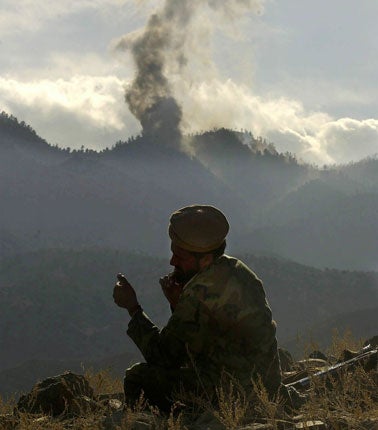Here, there and somewhere else: on the trail of the world's most-wanted
The 10-year hunt

For so long, talk about the whereabouts of Osama bin Laden has been qualified with obligatory caveats. He was believed to be here, it was suspected he could be there, analysts thought it possible he was operating somewhere else. Many were convinced he was long dead.
Indeed, for all but a tiny number of people, until yesterday morning, for any sort of certainty on the whereabouts of the man who earned the title of the world's most wanted, one had to go all the way back to December 2001 and the final stages of the operation to smash al-Qa'ida and its protectors, the Taliban, that the US and the UK launched in the aftermath of the 11 September attacks that had so stunned the West.
As US forces and the Northern Alliance were routing the Taliban and spreading out to hunt for Bin Laden and his network, a group of fighters holed up in caves in the mountains of Tora Bora, a remote spot that the militants were known to have developed over some years. Huge B-52 bombers were dispatched to destroy the cave system and the US authorities took a decision to block the escape routes, not with the 100 or so US Special Forces to hand, but with Afghan militia. In the years since, that decision has become known as a great blunder.
In the first days of December, Bin Laden managed to slip away. In an intercepted radio message, which officials believed with "reasonable certainty" to be Bin Laden, he urged his men to fight to the death. On 8 December came the report of a group of Arab fighters and their leader stopping for supplies at the village of Tangi, close to the border with Pakistan. Then there was nothing.
It was thought that Bin Laden and a small group of loyal fighters slipped across the border into Pakistan, avoiding the Pakistani troops that had been dispatched along the 1,500-mile porous border. More recently, testimony from detainees at Guantanamo Bay, obtained by WikiLeaks, had suggested Bin Laden may not have entered Pakistan but remained in Afghanistan. According to this theory, a local warlord provided Bin Laden, his deputy Ayman al-Zawahiri and his men, with up to 50 fighters to enable them to escape northwards, passing through the lines of US troops and their Afghan allies. According to a recent report in the Guardian, they made their way to the house of an Afghan sympathiser called Awal Malim Gul in or near the city of Jalalabad. From there, they travelled on, apparently on horseback, to Kunar province. They may have remained in that remote spot for the best part of a year.
In the anxious, chaotic months after 11 September, an attack that struck at the vulnerable underbelly, there appeared to be few more pressing issues than locating the man who had brought down the Twin Towers. "I want justice," president George Bush had announced in September after a meeting at the Pentagon where just days earlier, more than 188 people had been killed. "And there's an old poster out West that says, 'Wanted: Dead or Alive'."
But for all the efforts of the US and its allies – efforts that were hugely undermined as a result of Mr Bush's subsequent decision to invade Iraq – Bin Laden remained one step, or several, ahead of those who sought him. A flurry of possibilities were suggested as his hiding place, among them Saudi Arabia, Afghanistan, Indonesia and Yemen. Most analysts plumped for the wild regions of Pakistan, most likely South or North Waziristan, the areas where the remit of the state and the Pakistan military was at its weakest.
Experts were agreed that wherever he was, Bin Laden must have been living the most simple of lives, avoiding email and cellphones for fear of being detected by the electronic eavesdropping capabilities of the West, and instead – as appears to have been confirmed – relying on human couriers to deliver messages. Yet Bin Laden continued to taunt those who sought him, with video and audio recordings. Shortly before the 2004 election, he released a video telling American voters that Bush was "deceiving" them. There was another video – the most recent – in September 2007.
As analysts tried to discover where they had been recorded, questions were asked about who was helping Bin Laden. Many reports suggested he suffered from kidney problems and required regular dialysis. Just how was he managing to do this, they asked.
In 2009, a team from the University of California even claimed to have whittled down the variables with the use of satellite imagery and what they termed the "fundamental principles of geography". According to the lead author of the study, Thomas Gillespie, the most likely location for the fugitive was a series of walled compounds in the Kurram tribal area, less than 20 miles from Tora Bora where he went off the radar nearly a decade ago. "If he's still alive, he honestly could be sitting there right now," Mr Gillespie claimed.
It seems all were wrong. For now, there remain huge blanks in what is known publicly about Bin Laden's movements in the years between eluding US troops at Tora Bora and moving into the compound at Abbottabad, which US officials say was built in 2005. There are many caveats but also, finally, some certainty.
Join our commenting forum
Join thought-provoking conversations, follow other Independent readers and see their replies
Comments